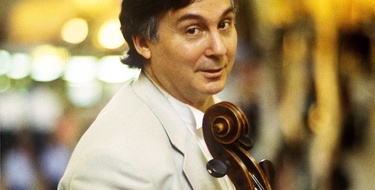All Kirshbaum Cello Lessons
Get all Ralph Kirshbaum´s cello videos and save 45% in this special introductory offer.
The cello bundle consists of 3 masterclasses and the extensive Cello Fundamental series covering the right and left handas well as the 60 minute talk between him and cello students.
All in all more than 6 hours teaching by one of today's greatest music artists and teachers.
See chapter list for more details.
Watch previews below to get a taste of Kirshbaum's teaching.
LESSON PLAN
01 Intro
02 Holding the bow
03 Sounding points and sound production
04 Application of weight
05 Oral pointillism
06 Beginning a note
07 Bow changes
08 String crossing
09 Bow speed
10 Articulation
11 Spiccato
12 Outro
13 Basic hand position
14 Shifting positions
15 Left Hand Articulation
16 Vibrato
17 Trilling
18 Pizzicato
19 Masterclass no 1, Beethoven 7 Variations
20 Masterclass no 2, Beethoven C major Sonata
21 Masterclass no 3, Haydn D major Concerto
22 Interview
Reviews
I must say I have never before been exposed to quite as much artistic insight on music making in so short a time and it is wonderful that I can go back to the videos time and again, whenever I want. The Ralph Kirshbaum Cello Bundle seems to me a rare opportunity to learn what such an artist as the current holder of the Piatigorsky Chair at USC thinks and does technically and artistically and to see and hear it applied. The Fundamentals portion alone is well worth what I paid for the entire Cello Bundle. When having a lesson one usually gets the teacher's comments on the student's actions, sound, and interpretation, but not nearly so much of the teacher's insights as this video provides. His ideas about technique are very open minded: he is not at all parochial about how you hold your arm, fingers, or bow. Thus cellists from almost any pedagogical background can learn from what he says and demonstrates without much revision. I take issue with the way the Pizzicato segment was filmed - not enough right hand is shown - and the camera angle could/should be different for that segment. I think there is some weakness in the Vibrato segment. There is actually quite a lot of controversy about how vibrato is centered, and recent "scientific" measurements do seem to show it the fundamental tone is more centered than "at the top" of the range. Even we players who think we are vibrating up to the pitch seem to ignore the overshoot of the upper edge of the finger (I was one such player until I read the literature last week). Another important factor, that may not be apparent to someone who plays a Montagnana and whose students have cellos of Thornton School caliber - not all cellos respond that well to rather tame vibrato. And finally, on this subject: the way vibrato really works successfully is to engage the strongest overtones of the fundamental tones near the target pitch and what these overtones are, how strong they are is very dependent on an instrument's quality. A player who vibratos to get the desired sound (which Kirshbaum does and describes very beautifully) is thus at the mercy of the instrument's characteristics and has to adjust vibrato to match. I think it is helpful to know what is going on acoustically to create the desired effect. I am a happy customer!

